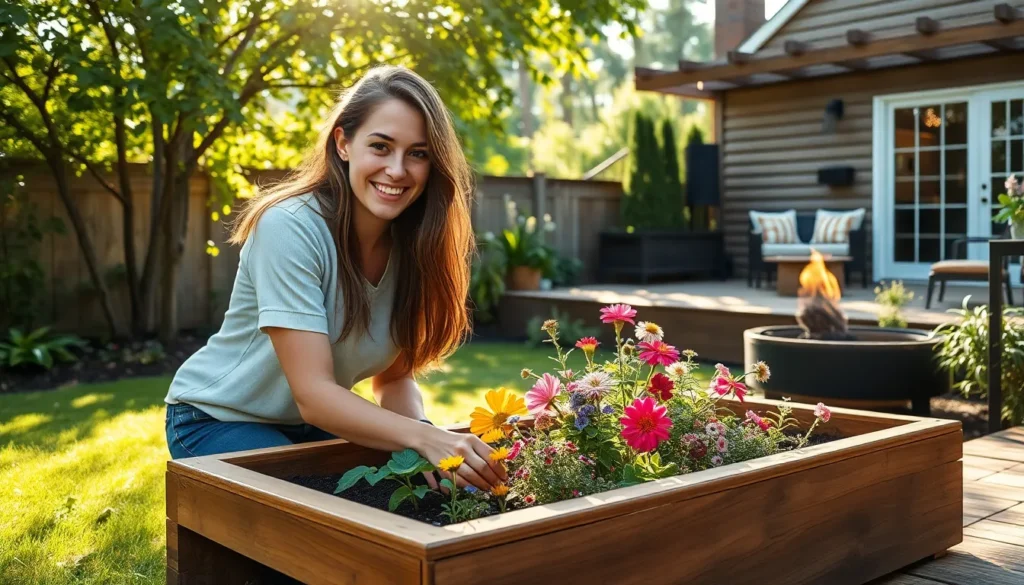We’ve all dreamed of stepping into our backyard and feeling like we’ve entered a personal paradise. Whether you’re working with a sprawling lawn or a compact urban space your outdoor area holds incredible potential for transformation. The right landscaping ideas can turn even the most neglected yard into a stunning retreat that boosts your home’s value and creates the perfect space for entertaining relaxation and family gatherings.
From budget-friendly DIY projects to ambitious design overhauls we’ll explore creative answers that work for every skill level and budget. You don’t need to be a professional landscaper to create dramatic changes that’ll have your neighbors asking for your secrets.
Ready to transform your outdoor space into the backyard oasis you’ve always wanted? Let’s jump into proven landscaping strategies that’ll help you maximize your yard’s potential and create an outdoor environment you’ll absolutely love spending time in.
Create a Stunning Focal Point With Water Features
Water features serve as magnificent centerpieces that instantly elevate any backyard landscaping design. The gentle sounds of flowing water create a tranquil atmosphere while adding visual interest to outdoor spaces.
Install a Modern Fountain or Waterfall
Fountains transform ordinary yards into sophisticated outdoor sanctuaries with their elegant presence and soothing water sounds. We recommend choosing from three main styles: tiered fountains for traditional appeal, contemporary geometric designs for modern homes, or natural stone waterfalls for rustic charm.
Installation requires selecting the right location with access to electrical outlets and level ground. Most pre-fabricated fountains come with complete pump systems that connect directly to standard household outlets. Professional installation costs range from $500 to $2,500 depending on size and complexity.
Maintenance involves weekly water level checks and monthly pump cleaning to ensure optimal performance. Adding algae treatment tablets every few weeks keeps water crystal clear throughout the growing season.
Add a Peaceful Koi Pond or Reflecting Pool
Koi ponds create living ecosystems that provide endless entertainment while serving as stunning industry focal points. These water features typically measure 6 to 8 feet in diameter and require depths of at least 3 feet to protect fish during winter months.
Reflecting pools offer similar visual impact without the maintenance requirements of live fish. Simple rectangular or circular designs work best for contemporary landscapes, while irregular shapes complement natural garden settings.
Budget considerations include excavation costs of $1,000 to $3,000 for medium-sized ponds, plus liner materials and filtration systems. Koi fish typically cost $50 to $200 each, with starter collections of 5 to 10 fish creating vibrant underwater displays.
Both options require proper filtration systems and regular water testing to maintain healthy environments. Weekly skimming removes debris while monthly filter cleaning ensures clear water conditions.
Design a Natural Stream Through Your Garden
Streams create ever-changing water movement that guides visitors through garden spaces while connecting different industry areas. We suggest incorporating gentle curves and varying widths to mimic natural waterways found in woodland settings.
Construction involves digging a shallow channel 12 to 18 inches wide and lining it with rubber membrane before adding river rocks and pebbles. Recirculating pumps move water from collection basins back to stream sources, creating continuous flow without waste.
Plant selection includes moisture-loving species like hostas, ferns, and ornamental grasses along stream banks. These plants soften hard edges while creating natural habitats that attract beneficial wildlife to garden spaces.
Lighting options such as underwater LED strips or strategically placed spotlights extend enjoyment into evening hours. Solar-powered fixtures eliminate electrical complications while providing eco-friendly illumination that highlights moving water and surrounding plantings.
Design Functional Outdoor Living Spaces
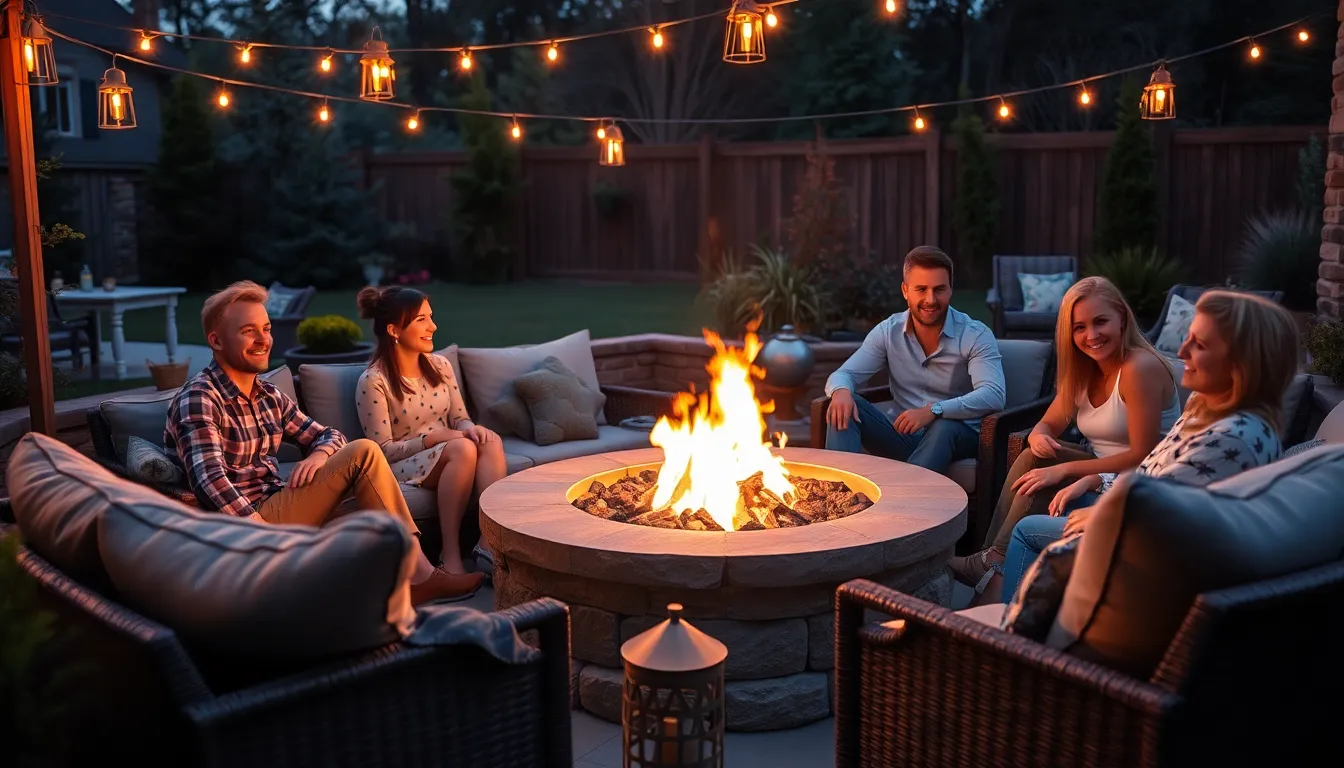
Building upon the serene atmosphere created by water features, we can transform our backyards into comprehensive living spaces that rival indoor comfort. Functional outdoor areas maximize our yard’s potential while creating distinct zones for various activities.
Build a Cozy Fire Pit Area for Gatherings
Fire pits serve as natural gathering magnets that promote social interaction and provide warmth during cooler evenings. We recommend positioning the fire pit at least 10 feet away from structures and overhanging branches for safety. Stone, brick, or metal fire pit options range from $50 for portable models to $3,000 for custom installations.
Seating arrangements around fire pits create intimate conversation circles where guests naturally face each other. Built-in stone benches, weatherproof outdoor sofas, or moveable chairs work effectively. We suggest maintaining 36 inches between seating and the fire pit edge for comfort and safety.
Decorative elements enhance the fire pit’s ambiance through strategic lighting and accessories. String lights, lanterns, or hammocks nearby create magical evening atmospheres. Adding weather-resistant storage benches provides seating while hiding firewood, blankets, and roasting supplies.
Create an Outdoor Kitchen and Dining Zone
Outdoor kitchens extend our cooking capabilities beyond basic grilling to full meal preparation. Essential components include grills, outdoor refrigerators, sinks, and prep surfaces made from weather-resistant materials like stainless steel or stone. Complete outdoor kitchen installations typically cost between $5,000 and $20,000 depending on features and finishes.
Cooking surfaces should accommodate various preparation needs from grilling and smoking to food prep and cleanup. We recommend including at least 36 inches of counter space adjacent to cooking appliances. Built-in storage cabinets protect utensils, dishes, and non-perishable ingredients from weather exposure.
Dining areas complement outdoor kitchens by providing comfortable spaces for family meals and entertaining. Weather-resistant dining tables and chairs made from teak, aluminum, or synthetic materials withstand outdoor conditions. We suggest positioning dining areas within 10 feet of cooking zones for convenient food service.
Establish a Relaxing Reading Nook
Secluded reading areas offer peaceful retreats within our outdoor living spaces. We recommend choosing quiet spots away from high-traffic areas and noise sources like pools or play areas. Corner locations or areas behind industry features provide natural privacy and wind protection.
Comfortable seating forms the foundation of successful reading nooks. Plush outdoor chairs with weather-resistant cushions, hanging egg chairs, or hammocks create inviting spots for extended reading sessions. We suggest adding side tables or built-in surfaces for books, beverages, and reading accessories.
Surrounding greenery enhances privacy and ambiance while creating natural boundaries around reading spaces. Trellises with climbing vines, tall ornamental grasses, or strategically placed shrubs provide screening without completely isolating the area. These plant barriers also reduce wind and create cooler microclimates during hot weather.
Incorporate Vertical Gardening Solutions
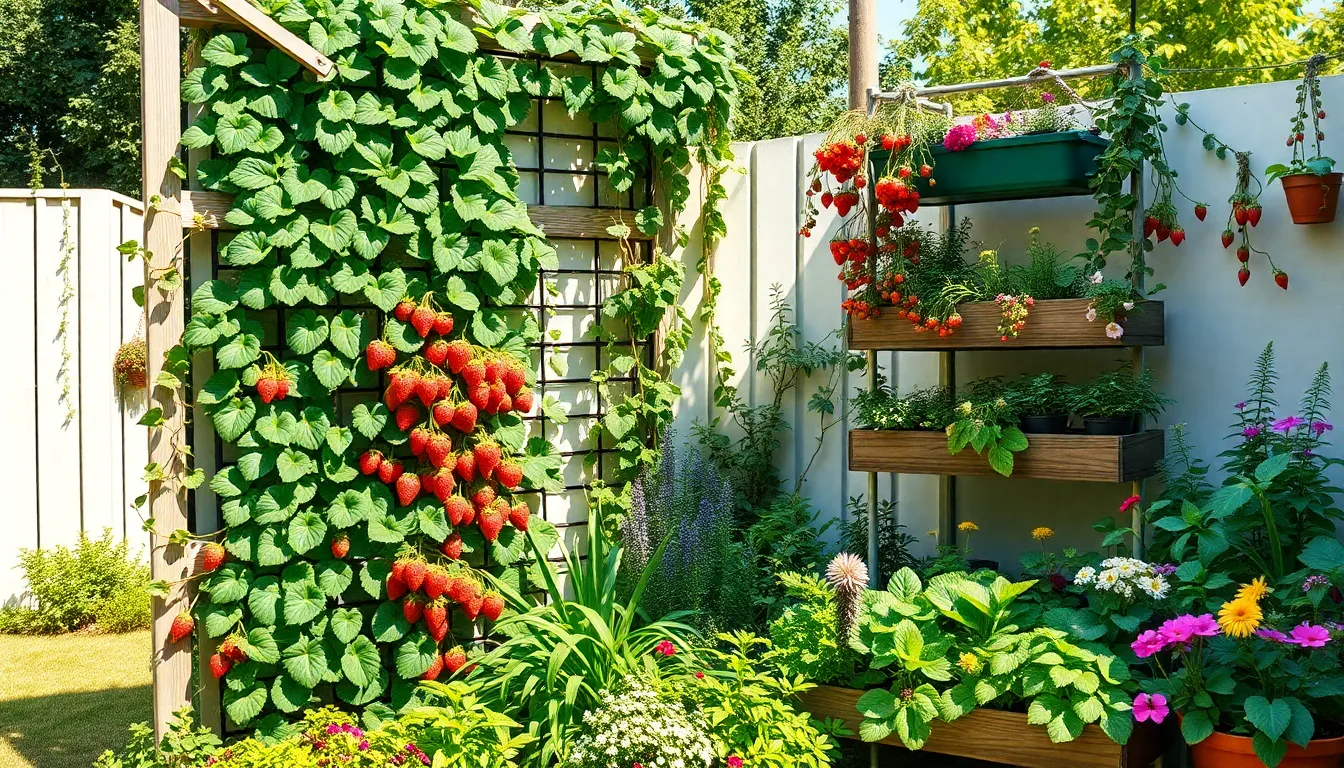
We can maximize our backyard’s potential by expanding upward when horizontal space becomes limited. Vertical gardening offers cost-effective answers that make gardens easier to maintain while creating stunning visual appeal.
Install Living Walls and Green Screens
Living walls transform blank surfaces into thriving ecosystems that provide both beauty and functionality. We’ll find these installations particularly effective for adding privacy while hiding unsightly areas like utility boxes or neighboring fences. Green screens create natural barriers that filter noise and improve air quality around our outdoor living spaces.
Plants like nasturtiums work exceptionally well in vertical arrangements since they’re both edible and attractive. We can use slat walls or hanging planters to create unique designs that suit both indoor and outdoor environments. These systems require minimal floor space while delivering maximum visual impact throughout our landscaping design.
Use Trellises for Climbing Plants
Trellises provide essential support for climbing plants that would otherwise sprawl across valuable ground space. We’ll discover that sturdy structures work best for heavier vines like grapes and melons, which require substantial support as they mature. Training vines regularly along trellis frameworks ensures they receive adequate support while maintaining attractive growth patterns.
Vegetables like cucumbers, green beans, peas, and squash thrive when grown vertically on trellis systems. We can harvest these crops more easily when they’re elevated, and the improved air circulation reduces disease problems common in ground level plantings. Installing trellises against walls or fences doubles their effectiveness by utilizing existing structures.
Create Tiered Planter Arrangements
Tiered planters offer layered aesthetics that maximize growing space while adding dimensional interest to our garden design. We’ll appreciate the flexibility these arrangements provide since we can easily rearrange or replace plants as seasons change or our preferences evolve. Multiple levels allow us to group plants with similar water and light requirements while creating stunning cascading effects.
Strawberries perform exceptionally well in tiered systems where their trailing runners can spill naturally between levels. We can combine flowering plants with herbs and vegetables to create functional beauty that serves multiple purposes throughout our backyard industry. These arrangements work particularly well in corners or against walls where they won’t obstruct views or pathways.
Establish Defined Garden Zones and Pathways
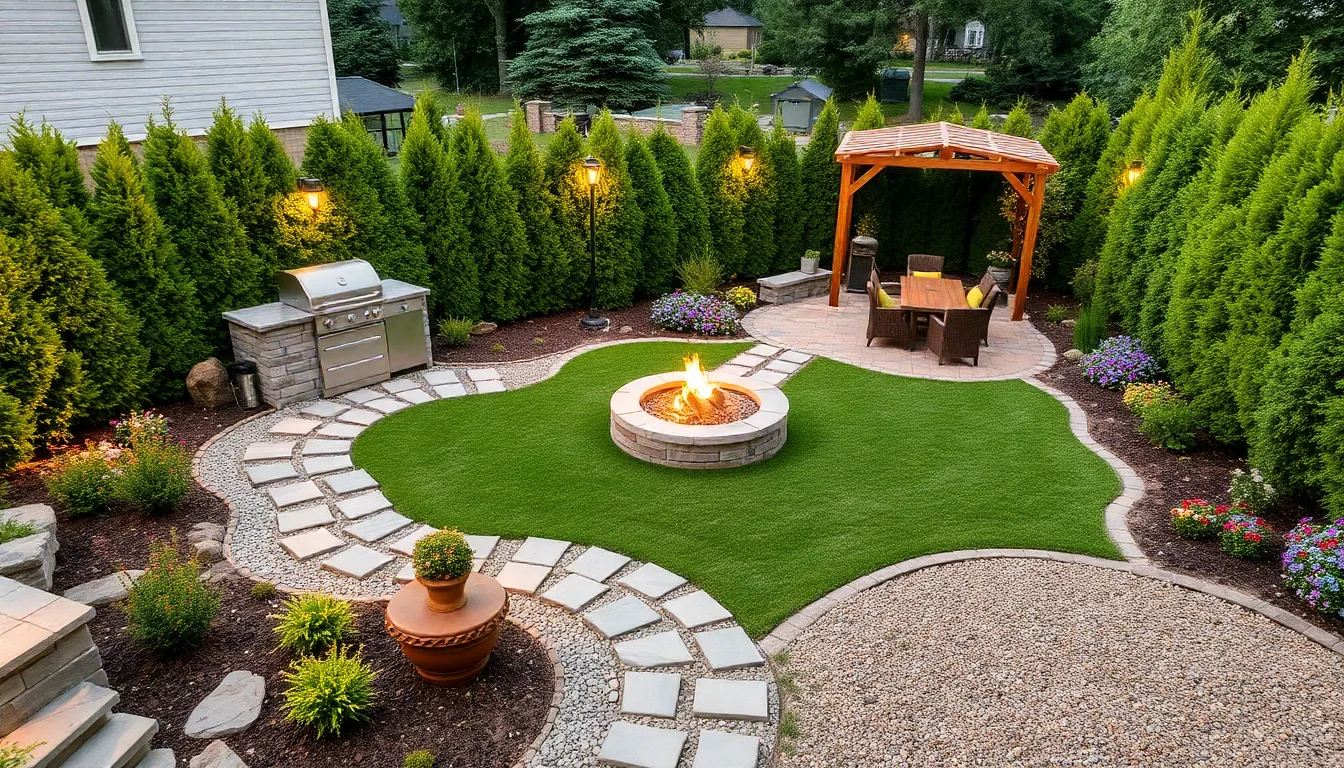
Transforming your backyard into organized, purposeful spaces creates visual appeal and maximizes functionality. We’ll guide you through creating distinct zones that flow seamlessly together while serving different purposes.
Design Winding Stone or Gravel Walkways
Stone pathways serve as the backbone of well-organized garden design, connecting different areas while adding natural beauty to your industry. We recommend choosing materials like flagstone, brick, or decomposed granite for their durability and aesthetic appeal.
Gravel walkways offer excellent drainage and cost-effective installation compared to solid stone options. You can create meandering patterns that guide visitors naturally through your garden zones, avoiding straight lines that can feel rigid or uninviting.
Lighting enhances pathway safety and extends evening enjoyment of your outdoor spaces. We suggest installing solar-powered lights along walkway edges, which eliminate wiring needs and provide eco-friendly illumination throughout the night.
Width considerations matter when planning your pathways. We recommend 4-5 feet for main walkways and 2-3 feet for secondary paths, ensuring comfortable passage while maintaining proportional balance with surrounding plantings.
Create Separate Areas for Different Activities
Outdoor kitchens establish dedicated entertaining zones that rival indoor cooking experiences. We suggest including essential components like grills, countertop space, and storage areas to create fully functional cooking environments.
Fire pit areas become natural gathering spots that extend outdoor season enjoyment into cooler months. Position comfortable seating in circular arrangements around fire features, creating intimate conversation spaces that encourage social interaction.
Play zones designated for children require careful planning to ensure safety while maintaining industry aesthetics. We recommend using soft groundcover materials like mulch or rubber mats beneath play equipment, bordered by attractive fencing or plantings.
Reading nooks provide peaceful retreats within busy outdoor environments. Create these quiet spaces using comfortable seating surrounded by screening plants or decorative elements that offer privacy and tranquility.
Use Hedges and Borders to Define Spaces
Hedges create natural barriers between activity zones while providing privacy and wind protection. We recommend evergreen varieties like boxwood or privet for year-round structure, or flowering options like hydrangeas for seasonal color.
Plant borders add definition and visual interest along pathway edges and zone boundaries. Mix perennials, annuals, and groundcovers to create layered textures and extended blooming periods throughout growing seasons.
Height variation in border plantings prevents monotonous appearances while creating depth and dimension. We suggest using taller plants as backdrops, medium-height specimens in middle layers, and low-growing varieties as front borders.
Maintenance requirements vary significantly among hedge and border choices. Consider your available time and gardening experience when selecting plants, choosing low-maintenance native species for easier long-term care.
Add Dramatic Lighting for Evening Appeal
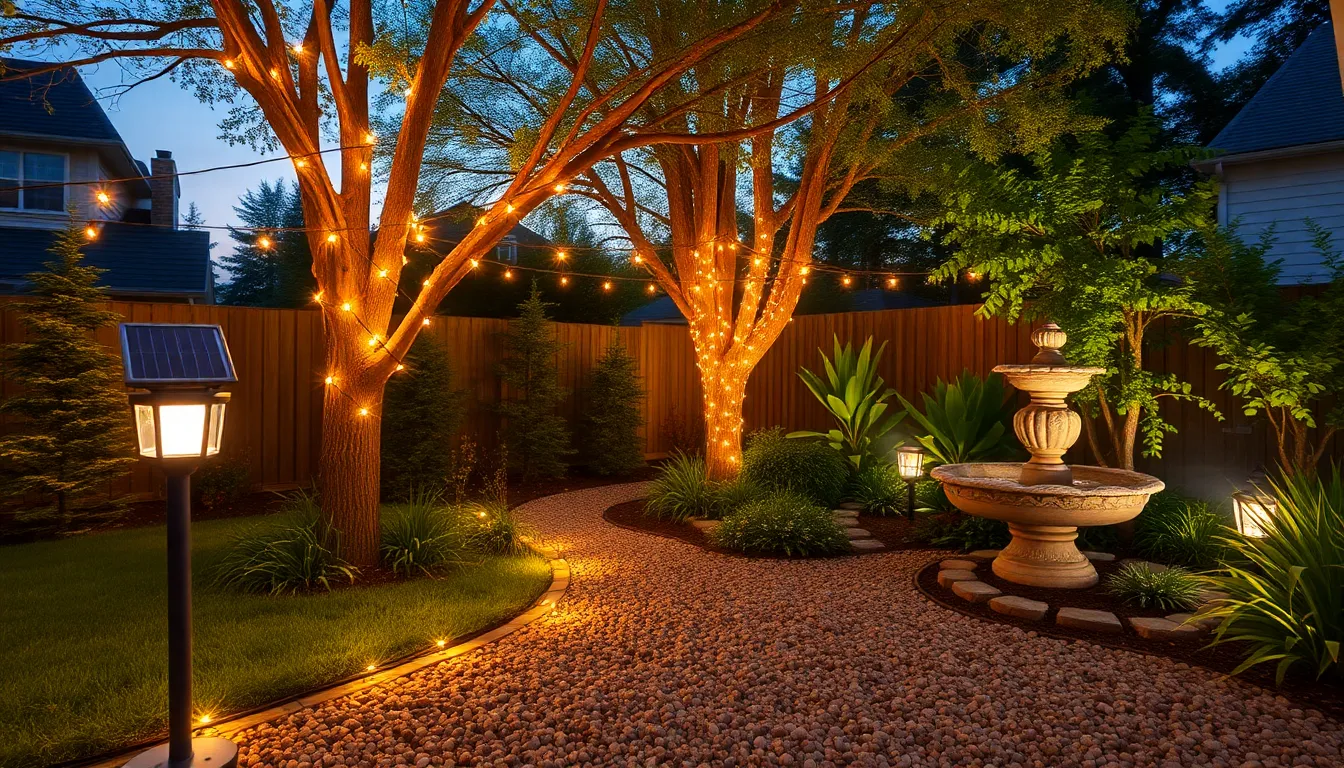
Transforming your backyard into an enchanting evening retreat requires strategic lighting that extends enjoyment well past sunset. We’ll explore three powerful lighting techniques that dramatically enhance your outdoor space’s appeal while maximizing both functionality and aesthetic impact.
Install Solar-Powered Industry Lights
Solar-powered lights offer an eco-friendly solution that eliminates electricity costs while providing reliable pathway illumination. We recommend positioning these energy-efficient fixtures along walkways to guide visitors safely through your yard without increasing monthly utility bills.
Modern solar industry lights automatically charge during daylight hours and activate at dusk, requiring zero maintenance once installed. Position them every 6-8 feet along garden borders and pathways for optimal light distribution. These fixtures work exceptionally well in areas where running electrical wiring would be challenging or expensive.
Most quality solar lights provide 8-10 hours of illumination after a full day’s charge, making them perfect for extended evening gatherings. We’ve found that LED solar lights offer the brightest output and longest lifespan compared to traditional bulb options.
Create Ambient Lighting With String Lights
String lights instantly transform ordinary outdoor spaces into magical gathering areas that invite relaxation and conversation. We suggest wrapping Edison bulb string lights around tree trunks, deck railings, or trellises to create charming focal points with vintage appeal.
Hanging string lights above outdoor dining areas creates an intimate atmosphere perfect for evening meals and entertaining guests. Position them in gentle curves rather than straight lines to achieve a more natural, organic feel that complements your landscaping.
Fire pit areas benefit tremendously from surrounding string light installations that extend the cozy ambiance beyond the flame’s reach. We recommend using warm-toned LED string lights for energy efficiency and durability in outdoor conditions. These lights typically consume 80% less energy than incandescent alternatives while lasting 25 times longer.
Highlight Key Features With Spotlights
Spotlights serve as powerful tools for accentuating your yard’s most impressive elements after dark. We recommend using cool-toned LED spotlights and floodlights to make your outdoor space feel larger and brighter while highlighting architectural features.
Tree lighting creates particularly dramatic effects when you employ low-voltage up-lighting positioned at the base of mature trees. This technique draws attention upward while casting beautiful shadow patterns that add depth and tranquility to your evening industry.
Position spotlights strategically to illuminate sculptures, water features, or unique garden installations that serve as focal points during daylight hours. We’ve discovered that angling lights at 30-45 degrees prevents harsh glare while maximizing visual impact. Use fixtures with adjustable heads to fine-tune the lighting direction as plants grow and change throughout seasons.
Choose Low-Maintenance Native Plant Options
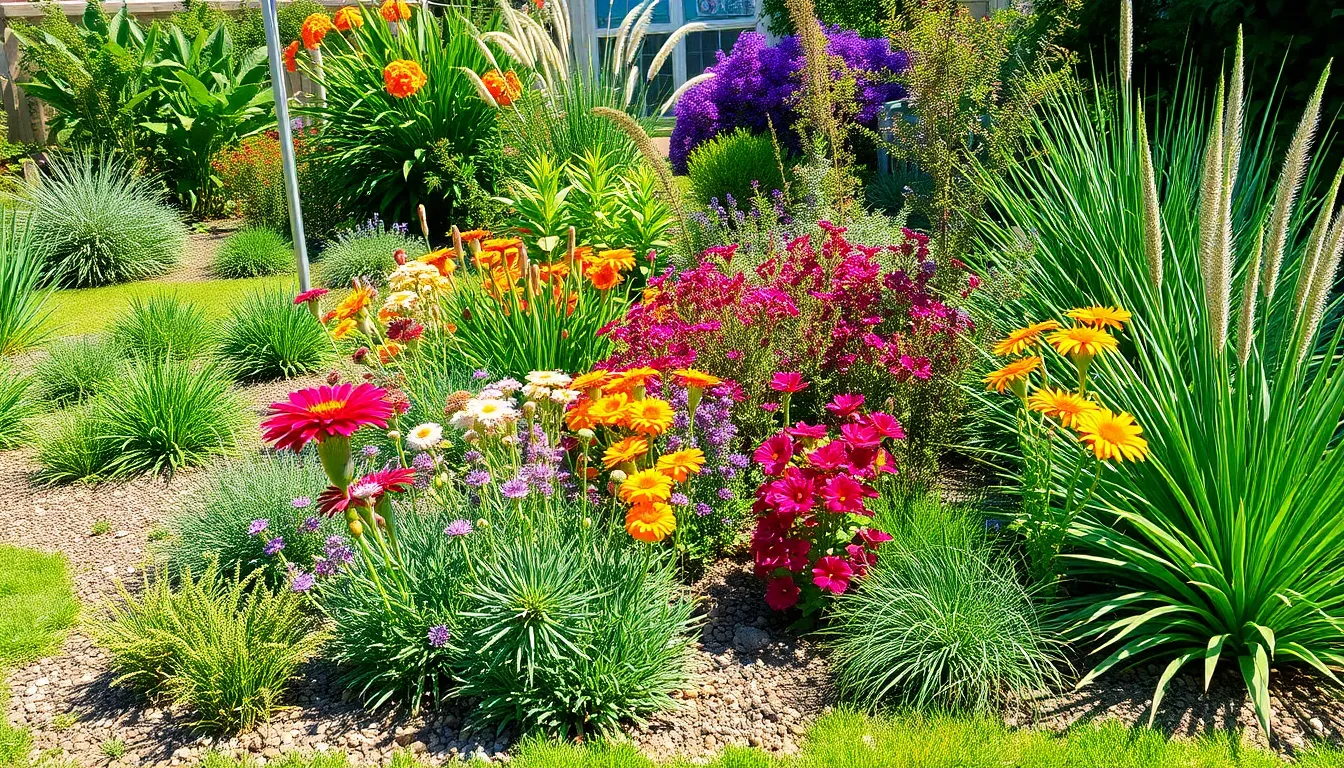
After establishing beautiful zones and dramatic lighting in your backyard, we’ll focus on selecting plants that thrive naturally in your environment. Native plants offer the perfect solution for busy homeowners who want stunning landscapes without constant upkeep.
Select Drought-Resistant Perennials
Drought-resistant perennials form the backbone of any low-maintenance landscaping project. Plants like blue-eyed grass and little bluestem maintain their vibrant colors throughout the season while requiring minimal watering once established. These hardy perennials adapt to your local climate conditions and significantly reduce irrigation needs.
We recommend incorporating compass plant (Silphium laciniatum) and cup plant (Silphium perfoliatum) for their impressive structural presence and minimal care requirements. Both species develop deep root systems that access groundwater naturally, making them ideal for areas with limited rainfall. Indigos (Baptisia spp.) offer beautiful seasonal blooms while providing year-round garden structure with their attractive seed pods.
Incorporate Native Grasses and Groundcover
Native grasses create natural barriers against weeds while adding texture and movement to your industry design. Switchgrass and little bluestem establish dense root systems that prevent unwanted plant growth, reducing your weeding time significantly. These grasses also provide habitat for beneficial wildlife and require no fertilizers or pesticides.
Groundcover plants like Canadian ginger fill empty spaces effectively while suppressing weed development. This approach creates a living mulch that retains soil moisture and reduces maintenance tasks. We suggest planting groundcover in areas where traditional grass struggles to grow, such as under trees or on slopes.
Plant Seasonal Flowers for Year-Round Color
Seasonal flowering plants ensure your garden remains vibrant throughout different times of the year. Trumpet honeysuckle provides brilliant orange-red blooms that attract hummingbirds during summer months, while cardinal flower offers striking red spikes in late summer and fall. These native bloomers require less water and fertilizer than non-native alternatives.
Strategic placement of seasonal flowers creates continuous color cycles that keep your industry interesting year-round. Early spring bulbs can complement late-season bloomers, ensuring something beautiful catches the eye during every season. This thoughtful approach eliminates the need for frequent replanting while maintaining visual appeal throughout changing weather conditions.
Build Elevated Structures for Visual Interest
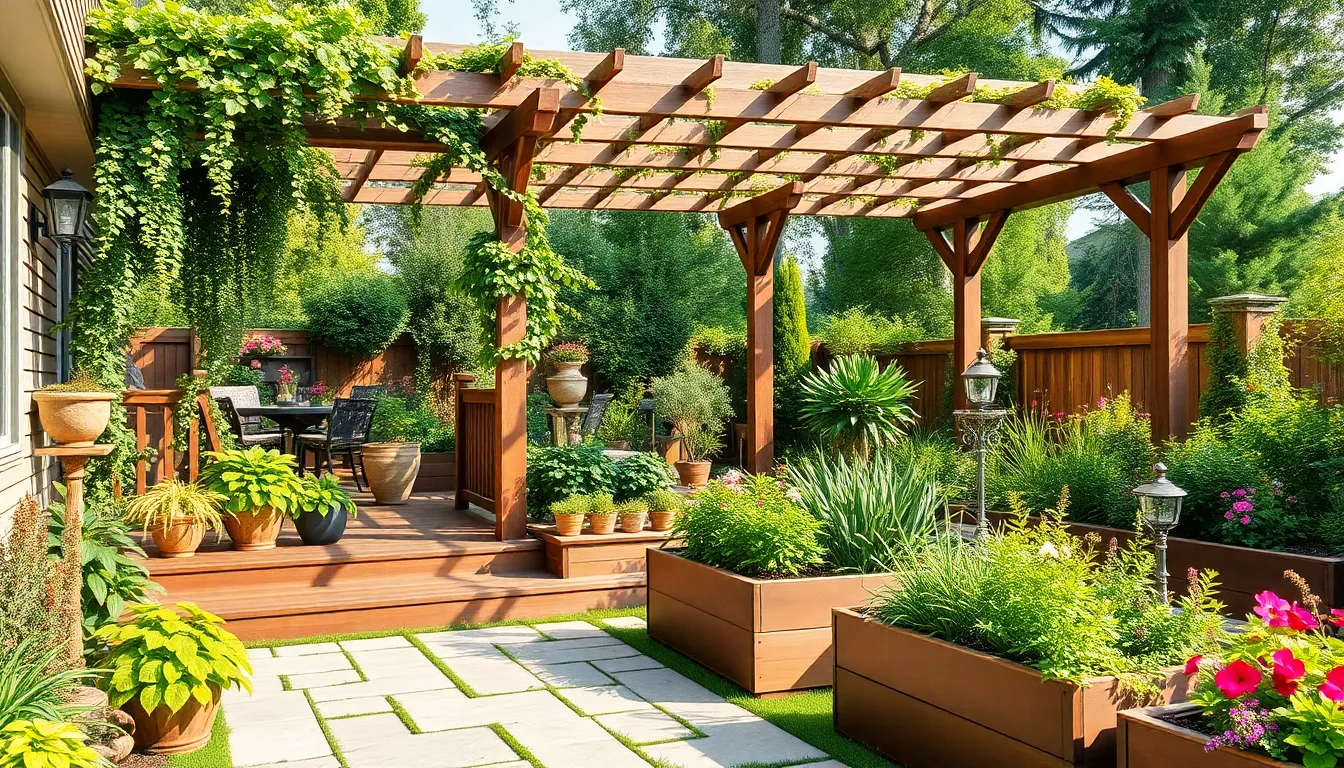
Moving from ground-level features to vertical elements transforms your industry into a multi-dimensional outdoor paradise. Elevation creates depth and draws the eye upward, making even modest yards feel more spacious and visually captivating.
Construct a Wooden Deck or Patio
Wooden decks and patios serve as versatile foundations for outdoor dining, relaxation, and entertainment activities. We recommend elevating these structures to provide better views of your surrounding industry while creating natural separation between different outdoor zones. Stone borders around elevated wooden decks add sophisticated contrast and help define the space visually.
Materials like cedar and composite decking offer durability against weather while maintaining aesthetic appeal. Elevated positioning allows for creative storage answers underneath and improves drainage around your outdoor living areas. We suggest incorporating ornamental plants along deck edges to soften hard lines and blend the structure with your garden’s natural elements.
Add a Pergola or Gazebo for Shade
Pergolas and gazebos create stunning focal points while providing essential shade for comfortable outdoor living. These structures serve dual purposes as both functional shade providers and architectural elements that anchor your industry design. We recommend positioning them over seating areas or walkways to maximize their practical benefits.
Climbing plants and vines transform these structures into living features that change with the seasons. Popular options include grape vines, clematis, and jasmine, which add fragrance and natural beauty while improving the structure’s shade capabilities. Materials range from traditional wood to modern aluminum, allowing you to match your home’s architectural style.
Create Raised Garden Beds at Different Heights
Raised garden beds at varying heights improve soil drainage while creating visually compelling industry features. Terraced designs work particularly well for managing sloping backyards, turning challenging terrain into attractive growing spaces. We suggest building beds at 12, 18, and 24-inch heights to create natural tiers that guide the eye through your garden.
Different elevation levels allow us to group plants with similar water and sunlight needs while creating distinct growing zones. Higher beds provide better accessibility for maintenance and harvesting, reducing strain on your back and knees. This layered approach enhances your garden’s network diversity by accommodating various plant types at optimal growing levels.
Integrate Sustainable and Eco-Friendly Elements
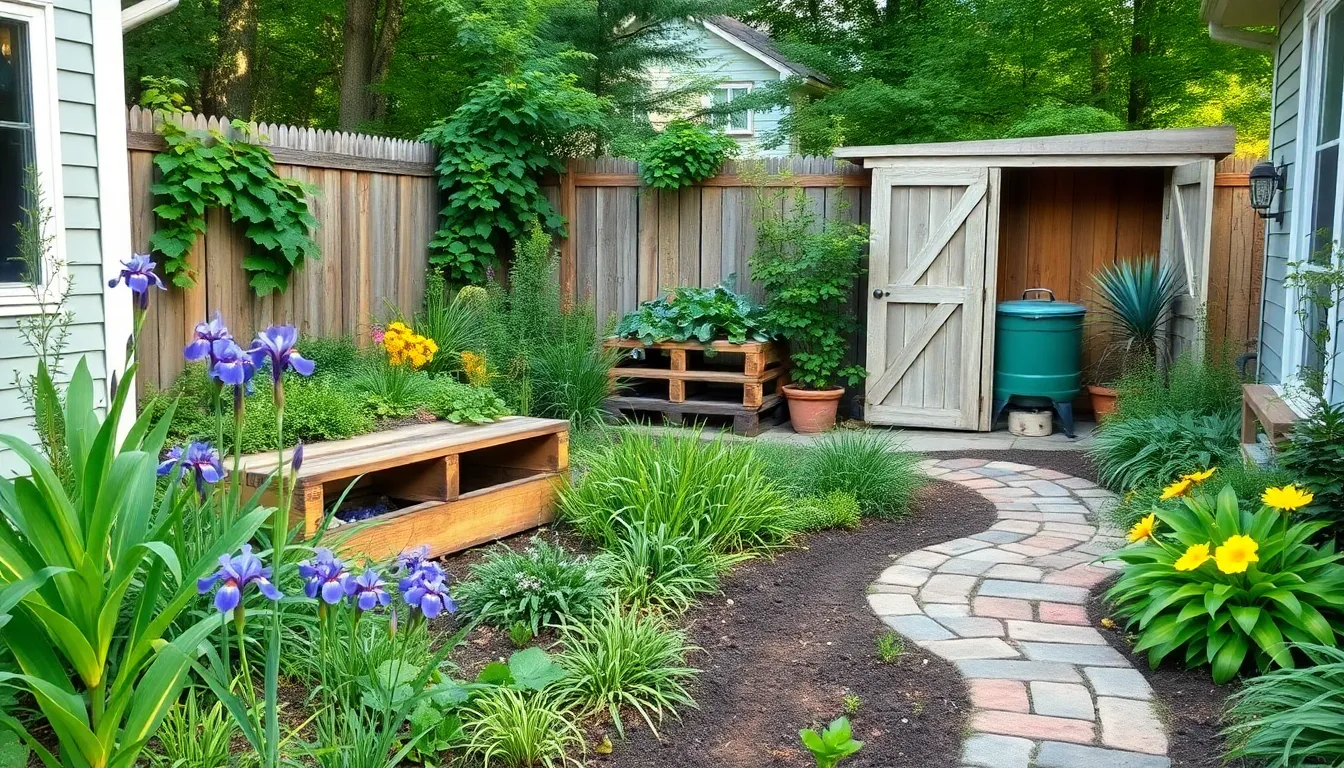
Building on the elevated structures we’ve discussed, we can now transform our outdoor spaces into environmentally responsible landscapes that work with nature rather than against it. Sustainable landscaping elements not only reduce our environmental impact but also create low-maintenance systems that save time and money while supporting local ecosystems.
Install Rain Gardens for Water Management
Rain gardens capture and filter stormwater runoff naturally, reducing the burden on municipal drainage systems while preventing erosion in our yards. These specialized planted areas collect rainwater from roofs, driveways, and other hard surfaces, allowing it to slowly percolate into the soil rather than rushing into storm drains.
Design your rain garden in low-lying areas where water naturally accumulates, positioning it at least 10 feet from your home’s foundation. Native plants like blue flag iris, cardinal flower, and swamp milkweed thrive in these moisture-rich environments while requiring minimal maintenance once established.
Bioswales offer another effective water management solution, functioning as shallow channels lined with vegetation that slow and filter runoff water. We recommend creating bioswales along driveways or property edges using native grasses and wildflowers that can handle both wet and dry conditions.
Mulch application around rain garden plants helps retain moisture and suppress weeds while preventing soil erosion during heavy rainfall events. Organic mulches like shredded bark or compost also break down over time, adding nutrients to the soil and supporting beneficial microorganisms.
Use Recycled Materials for Hardscaping
Recycled materials transform waste into functional industry elements while reducing our environmental footprint and creating unique visual interest. Reclaimed wood from old barns or structures makes excellent material for garden beds, pergolas, and pathway borders, offering character that new materials simply can’t match.
Recycled concrete pavers provide durable surfaces for patios and walkways at a fraction of the cost of new materials. We can often source these from construction sites or demolition projects, giving them new life in our outdoor spaces while keeping them out of landfills.
Crushed glass serves as an innovative alternative to traditional gravel, offering excellent drainage while creating sparkling accents in garden beds and pathway surfaces. This recycled material comes in various colors and sizes, allowing us to customize our industry design while supporting waste reduction efforts.
Repurposed brick from old buildings or chimneys creates charming pathway surfaces and garden borders with timeless appeal. These materials often feature unique patina and weathering that adds instant character to our outdoor spaces while honoring the history embedded in these reclaimed elements.
Create a Composting Area
Composting stations convert kitchen scraps and yard waste into nutrient-rich soil amendments, reducing household waste while creating free fertilizer for our gardens. We can establish effective composting systems using simple three-bin configurations made from recycled pallets or wire mesh enclosures.
Kitchen scraps like vegetable peels, coffee grounds, and eggshells provide nitrogen-rich “green” materials that balance carbon-rich “brown” materials such as fallen leaves, paper, and dried grass clippings. This balanced approach creates optimal conditions for decomposition while preventing odors and pest problems.
Turning compost every two to three weeks accelerates the decomposition process and ensures proper aeration, typically producing finished compost within six to twelve months. We recommend using a pitchfork or compost aerator tool to mix materials thoroughly while monitoring moisture levels to maintain consistency similar to a wrung-out sponge.
Finished compost enriches soil structure and provides slow-release nutrients that support healthy plant growth without the environmental concerns associated with synthetic fertilizers. This dark, crumbly material improves soil drainage in clay soils while increasing water retention in sandy conditions, creating optimal growing environments for our sustainable landscapes.
Conclusion
Your backyard transformation journey doesn’t have to be overwhelming or expensive. We’ve shown you how to create stunning outdoor spaces through strategic water features dramatic lighting and sustainable plant choices that work with your local environment.
Remember that the best landscaping projects happen in phases. Start with one area that excites you most whether it’s a cozy fire pit zone or a vertical garden wall. As you gain confidence and see results you’ll naturally want to expand your vision.
The key is choosing elements that match your lifestyle and maintenance preferences. Native plants require less water eco-friendly materials reduce environmental impact and well-planned zones create functional spaces your family will actually use.
Your outdoor paradise is within reach. Take the first step today and watch your backyard evolve into the retreat you’ve always envisioned.
Frequently Asked Questions
What are the most effective water features for small backyards?
Modern fountains, small koi ponds, and reflecting pools work best for compact spaces. These features create stunning focal points while providing tranquil sounds. Consider wall-mounted fountains or tabletop water features if space is extremely limited. Proper filtration and strategic plant placement are essential for maintaining healthy water ecosystems and preventing maintenance issues.
How much does it cost to install an outdoor kitchen?
Basic outdoor kitchens start around $3,000-$5,000 for simple setups with a grill and prep space. Mid-range installations cost $10,000-$25,000, while luxury outdoor kitchens can exceed $50,000. Essential components include weather-resistant appliances, adequate storage, and proper ventilation. Consider starting small and expanding over time to manage costs effectively.
What are the best low-maintenance native plants for landscaping?
Drought-resistant perennials like blue-eyed grass and little bluestem require minimal watering and thrive in local climates. Native grasses suppress weeds naturally while retaining soil moisture. Seasonal flowering plants ensure year-round color with minimal upkeep. Choose plants adapted to your specific region for the best results and lowest maintenance requirements.
How can vertical gardening maximize small outdoor spaces?
Living walls and green screens enhance privacy while improving air quality. Trellises support climbing plants like cucumbers and grapes, making harvesting easier and promoting better air circulation. Tiered planter arrangements create visual interest and allow grouping of plants with similar needs. These solutions effectively utilize vertical space when horizontal area is limited.
What materials work best for creating garden pathways?
Flagstone and decomposed granite offer durability and natural aesthetics for garden walkways. Gravel paths are cost-effective and provide good drainage. Stone materials create winding, attractive routes that connect different garden areas. Consider adding pathway lighting for safety and evening enjoyment. Choose materials that complement your overall landscape design and climate conditions.
How do I create defined zones in my backyard?
Use hedges and borders to separate different activity areas naturally. Design distinct spaces for outdoor cooking, fire pit gatherings, children’s play areas, and quiet reading nooks. Winding pathways help connect these zones while maintaining flow. Strategic plant placement and varying heights create visual separation without walls or fences.
What lighting options work best for outdoor spaces?
Solar-powered lights provide eco-friendly pathway illumination without electrical work. String lights create cozy ambient lighting perfect for entertaining areas. Spotlights highlight key landscape features like trees, water features, or architectural elements. Combine different lighting types for layered illumination that enhances safety and extends outdoor enjoyment into evening hours.
How can I make my landscaping more sustainable?
Install rain gardens and bioswales for natural water management using native plants. Use recycled materials like reclaimed wood and recycled concrete pavers for hardscaping projects. Create composting areas to convert kitchen scraps and yard waste into nutrient-rich soil amendments. These eco-friendly approaches reduce environmental impact while creating beautiful, low-maintenance outdoor spaces.
What are the benefits of raised garden beds?
Raised beds improve soil drainage and create visually compelling garden features, especially on sloped terrain. They offer better accessibility for maintenance and harvesting. Varying heights add dimensional interest and allow for better organization of plants with different growing requirements. They also provide better soil control and can extend growing seasons.
How do I choose the right elevated structures for my yard?
Wooden decks and patios using cedar or composite materials create versatile foundations for outdoor living. Pergolas and gazebos provide shade and architectural interest while supporting climbing plants. Consider your space size, intended use, and maintenance preferences. These structures should complement your home’s architecture and enhance the overall landscape design while providing functional outdoor living areas.

